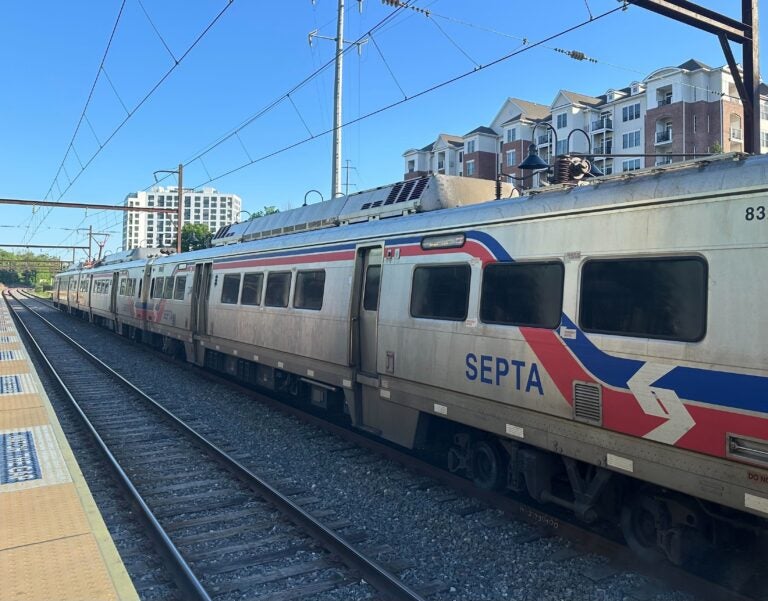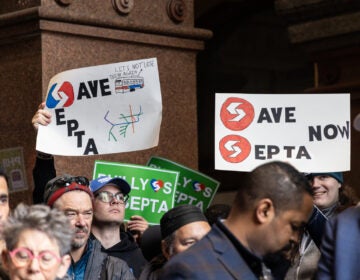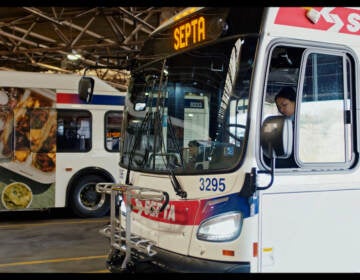Residential properties near SEPTA’s shrinking Regional Rail system stand to lose $20B in value, report estimates
If trains along five Regional Rail lines stop running, property values in Greater Philadelphia could plummet.
Listen 1:00
A train along the Norristown/Manayunk SEPTA Regional Rail line rolls through the Conshohocken station on a weekday morning. (Kristen Mosbrucker-Garza/WHYY)
Have a question about Philly’s neighborhoods or the systems that shape them? PlanPhilly reporters want to hear from you! Ask us a question or send us a story idea you think we should cover.
SEPTA’s sweeping service cuts don’t just affect riders — they could drag down property values in nearby communities, reduce tax revenues for public services and slow the economy, according to a recent economic impact analysis.
On July 1, the transit agency will face a $213 million budget shortfall. It was a $240 million budget deficit, but the organization imposed a hiring freeze and cut back some administrative costs.
As a result, SEPTA is proposing eliminating 50 bus routes and suspending service along five Regional Rail lines and one metro line. More than a dozen bus routes would be shortened, and a systemwide service reduction of 20% would mean routes running less frequently.
Philadelphia-based consultancy Econsult Solutions is often commissioned to calculate the economic impact of new commercial projects or big investments in communities. But instead of estimating how much economic value is generated by SEPTA, the company calculated what it would mean if the “death spiral” continued.
“The most obvious impact and pain really is the folks that either can’t use it on a daily basis for commutes they need to or are bearing higher prices, and that is a direct cost,” said Ethan Connor-Ross, executive vice president and principal at Econsult Solutions.
A public transportation system that’s not working means more traffic congestion and reduced productivity, which makes the region less competitive, Connor-Ross said.
“Ultimately you’re affecting your tax base. That’s going to play out in school districts and municipalities with less funding to do the basic services that everybody relies on,” he said.
For decades, living near a public transportation network has meant higher property values for homeowners, commercial buildings and office towers, according to sales data. But that equation is expected to change.
As early as August, the Paoli-Thorndale Regional Rail line could be cut back to every 30 minutes during rush hour, every hour during midday and off-peak hours and every two hours on weekends. SEPTA is proposing abandoning the line entirely by January 2026.
All remaining Regional Rail lines would operate every two hours — as opposed to one hour — during midday. And all trains would stop running after 9 p.m. each night.
The property value of single-family homes along Philadelphia’s Main Line could drop by $6.94 billion, according to the analysis. That’s a property value loss of $57,000 per household.
“That portion of the region is really built in a sense around that transit line and around that access,” Connor-Ross said. “If you were to lose service, houses start selling for less because of that diminution of value, and that’s going to work its way into your tax base.”
Four more Regional Rail lines would also be discontinued: Chestnut Hill West, Cynwyd, Trenton and Wilmington-Newark.
SEPTA pays $65 million each year to lease the railroad infrastructure to Amtrak for those Regional Rail lines — which is why the services are being eliminated.
There are about 682,000 single-family homes, and about $73 billion of commercial property value, within a 3-mile radius of all five Regional Rail lines on the chopping block. If there are no trains running, the collective value of those homes would drop by nearly $20 billion.
That means less tax revenue for local schools and municipalities. Many commercial corridors along transit routes rely on foot traffic, so fewer riders means fewer sales and business taxes paid to the state. And according to the analysis, office space vacancies are expected to increase if daily commutes are longer.
Closing the lines after 9 p.m. would curb the city’s economy after dark, from sporting events and concerts to night-shift workers at local hospitals and airport employees.
There are about 20,000 people who commute to the airport each day, from individuals working in logistics to major airline employees.
“It’s a huge job center for the city and the region and about a quarter of those workers rely on transit to get to work,” Connor-Ross said.
The analysis estimates that major transportation network disruptions would lead to fewer jobs, meaning less income taxes collected at the local and state levels.
About one-third of Pennsylvania residents live in the southeastern portion of the state on less than 5% of the land area and account for about 40% of the tax base — or $17.8 billion of the state’s general fund revenue in fiscal year 2023.
Over a 30-year period, a reduced SEPTA footprint would contribute to 76,700 fewer jobs in the Philadelphia region, the report estimates.
The state is expected to lose $241 million in annual tax revenue losses from income, sales, business and real estate transfer taxes. School districts in Philadelphia and the suburbs would lose $207 million in annual tax revenue from a decline in residential property values.
“It’s a very perilous moment,” Connor-Ross said. “It’s a really drastic set of cuts that are on the table. And we think that the flowthrough of economic impacts from that are something that folks should be very alarmed about.”

Subscribe to PlanPhilly
WHYY is your source for fact-based, in-depth journalism and information. As a nonprofit organization, we rely on financial support from readers like you. Please give today.









